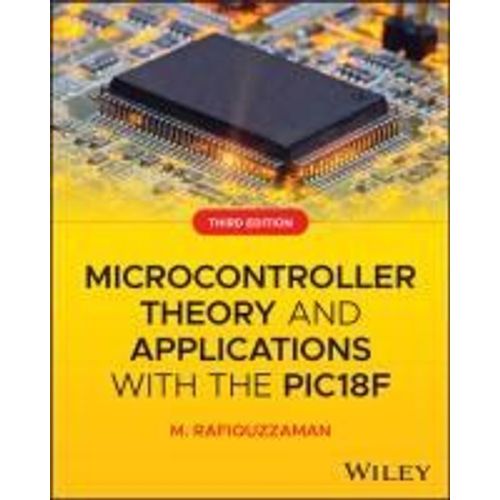

Microcontroller Theory and Applications with the Pic18f - Rafiquzzaman, M.
- Format: Relié
- 496.0 pages Voir le descriptif
Vous en avez un à vendre ?
Vendez-le-vôtre256,99 €
Produit Neuf
Ou 64,25 € /mois
- Livraison : 25,00 €
- Livré entre le 7 et le 12 août
- Payez directement sur Rakuten (CB, PayPal, 4xCB...)
- Récupérez le produit directement chez le vendeur
- Rakuten vous rembourse en cas de problème
Gratuit et sans engagement
Félicitations !
Nous sommes heureux de vous compter parmi nos membres du Club Rakuten !
TROUVER UN MAGASIN
Retour

Avis sur Microcontroller Theory And Applications With The Pic18f Format Relié - Livre
0 avis sur Microcontroller Theory And Applications With The Pic18f Format Relié - Livre
Donnez votre avis et cumulez 5
Les avis publiés font l'objet d'un contrôle automatisé de Rakuten.
Présentation Microcontroller Theory And Applications With The Pic18f Format Relié
- LivreAuteur(s) : Rafiquzzaman, M.Editeur : WileyLangue : AnglaisParution : 01/02/2025Format : Moyen, de 350g à 1kgNombre de pages : 496.0 Résumé :This new edition of...

Résumé :
This new edition of Microcontroller Theory and Applications with the PIC18F, Third Edition is an enhanced analysis of the interfacing techniques associated with Microchip's PIC18F4321 microcontroller through fundamental concepts of assembly and C language programming. Over the course of 11 chapters, this edition includes extended coverage on basic topics from the last edition, emphasizing characteristics, principles, and interfacing techniques, now demonstrated through simple devices such as switches, LEDs, Seven-segment displays, then advanced devices like LCD displays and ADC. Complex topics like PWM, stack, bank-memory, Serial I/O, and CCP are presented in a simpler manner in this new edition for easier learning. Companion lecture slides are readily available to supplement teaching--...
Biographie: M. Rafiquzzaman, Ph.D., P.E, Professor Emeritus, Electrical & Computer Engineering Department, California State Polytechnic University, Pomona, CA. Professor Rafiquzzaman has over 50 years of academic and industrial experience. He has authored 18 books (including all editions) on digital logic, microprocessors, microcontrollers, and computer architecture. His first popular book on microprocessors was published by Wiley in 1982 and his other books are published by Wiley, Prentice-Hall, CRC Press, Harper & Row, and West Publishing. Dr. Rafiquzzaman is a member of the US Olympic committee. He managed Swimming, Diving, and Synchronized Swimming events of the 1984 Los Angeles Olympic Organizing Committee. He is currently President of Rafi Systems Inc., a high tech cataract lens manufacturing company in California....
Sommaire: Preface xiii About the Companion Website xvii 1 Introduction to Microcontrollers 1 1.1 Explanation of Terms 3 1.2 Microcontroller Data Types 7 1.2.1 Unsigned and Signed Binary Numbers 7 1.2.2 ASCII and EBCDIC Codes 9 1.2.3 Unpacked and Packed Binary-Coded-Decimal Numbers 10 1.3 Evolution of the Microcontroller 10 1.4 Embedded Controllers 14 2 Microcontroller Basics 15 2.1 Basic Blocks of a Microcomputer 15 2.1.1 System Bus 16 2.1.2 Clock Signals 17 2.2 Microcontroller Architectures 18 2.3 Central Processing Unit (CPU) 19 2.3.1 Register Section 19 2.3.2 Control Unit 28 2.3.3 Arithmetic and Logic Unit (ALU) 29 2.3.4 Simplified Explanation of Control Unit Design 29 2.4 Basic Concept of Pipelining 30 2.5 RISC Versus CISC 32 2.6 Functional Representation of a Typical Microcontroller - The PIC18F 4321 33 Questions and Problems 34 3 Microcontroller Memory and Input/Output (I/O) 37 3.1 Introduction to Microcontroller Memory 37 3.1.1 Main Memory 38 3.1.2 READ and WRITE Timing Diagrams 40 3.1.3 Main Memory Organization 42 3.2 Microcontroller Input/Output (I/O) 45 3.2.1 Overview of Digital Output Circuits 47 3.2.2 Simple I/O Devices 49 3.2.3 Programmed I/O 51 3.2.4 Unconditional and Conditional Programmed I/O 52 3.2.5 Interrupt I/O 53 Questions and Problems 56 4 Programming Languages 61 4.1 Computer Programming Languages 61 4.2 Machine Language 62 4.3 Assembly Language 63 4.3.1 Types of Assemblers 64 4.3.2 Assembler Delimiters 65 4.3.3 Specifying Numbers by Typical Assemblers 65 4.3.4 Assembler Directives or Pseudoinstructions 65 4.3.5 Assembly Language Instruction Formats 67 4.3.6 Typical Instruction Set 69 4.3.7 Typical Addressing Modes 75 4.3.8 Subroutine Calls in Assembly Language 76 4.4 High-Level Language 77 4.5 Introduction to C Language 78 4.5.1 Data Types 81 4.5.2 Bit Manipulation Operators 81 4.5.3 Control Structures 83 4.5.4 The if-else Construct 83 4.5.5 The switch Construct 84 4.5.6 The while Construct 85 4.5.7 The for Construct 86 4.5.8 The do-while Construct 87 4.5.9 Structures and Unions 87 4.5.10 Functions in c 88 4.5.11 Arrays 89 4.5.12 Macros 89 4.6 Choosing a Programming Language 90 4.7 Flowcharts 90 Questions and Problems 91 5 PIC18F Architecture and Addressing Modes 93 5.1 Basic Features of the PIC18F Family 93 5.2 PIC18F Register Architecture 96 5.3 PIC18F Memory Organization 99 5.3.1 PIC18F Program Memory 100 5.3.2 PIC18F Data Memory 100 5.4 PIC18F Addressing Modes 104 5.4.1 Literal or Immediate Addressing Mode 104 5.4.2 Inherent or Implied Addressing Mode 104 5.4.3 Direct or Absolute Addressing Mode 105 5.4.4 Indirect Addressing Mode 105 5.4.5 Relative Addressing Mode 111 5.4.6 Bit Addressing Mode 113 Questions and Problems 113 6 Assembly Language Programming with the PIC18F: Part 1 115 6.1 Introduction to the PIC18F MPLAB Assembler 115 6.2 PIC18F Instruction Format 119 6.3 PIC18F Instruction Set 121 6.3.1 Data Movement Instructions 123 6.3.2 Arithmetic Instructions 128 6.3.3 Logic Instructions 137 6.3.4 Rotate Instructions 140 6.3.5 Bit Manipulation Instructions 144 6.3.6 PIC18F Test, Compare, and Skip instructions 147 Questions and Problems 153 7 Ass...
Détails de conformité du produit
Personne responsable dans l'UE
